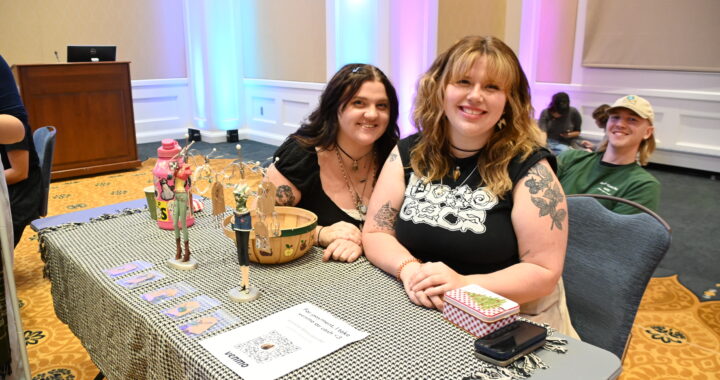WWI artifacts provides sensory study
3 min read
By ALISON THOET
The current students at the University of Mary Washington are of a generation that has always known what it is like to be at war, where war is constant. Many have read war histories, or at least the news of current U.S. involvements, but Mara Scanlon, professor of English, has offered a course this fall that exposes students to World War I, which just reached its centennial.
Student entered the classroom on Tuesday, Oct. 6 to a gas-masked donned mannequin presiding over bayonets, sword, bombs and other WWI materials splayed out on army printed tablecloths.
Nathan Skipper, bomb technician and member of the U.S. army of 24 years, brought a small portion of his personal world war memorabilia collection, over 100 items that is, to Scanlon’s “Literature of the Great War” course.
In a course where students are subjected to memoirs and poetry of in-your-face personal war histories, Skipper expressed a need for students to receive context on what soldiers carried, what they lived like and, most importantly, what killed them.
“This whole class is designed to be very sensory,” Skipper said. “What [the soldier] saw, what he felt, what he ate.”
Skipper began with the sense of smell, passing around vials containing the smell of the three main types of gas warfare, scents soldiers only picked up on if it was too late.
He then moved on to bombs, pointing out the shapes of grenades. Baseball, discus and egg-shaped grenades were lined up in a row and could easily fit in the hand of any young man in the war used to throwing.
“Think about this thing coming at you at 800 miles per second,” Skipper said as students delicately handled the metal shrapnel that could easily slice a face off, according to Skipper.
“It’s nice being able to have such a hands-on demonstration because the books we’re reading give me an idea of what war on the battlefield was like in WWI,” said senior English major Claire Winkler.
“Don’t forget to smell it,” insisted Skipper as he passed around a woolen tunic, jodhpur pants, hat and socks, all part of the uniform which belonged to an actual U.S. soldier between 14 and 16 years of age.
Skipper also showed the number of small things soldiers usually heaped into a pack that would add up to 60 to 85.
“This is the Vera Bradley of WWI,” Skipper quipped.
Keeping with the idea of sensory learning, Skipper passed around more weapons and pack materials, suggesting students smell and feel each object. However, he also brought a sample of “bully beef and crackers,” the typical WWI era ration food, for each student to taste.
“Mr. Skipper was a brilliant, natural teacher and a true expert,” Scanlon said. “He conveyed what an ordinary soldier’s life might be like by focusing on our sensory experience – the smells of gas, the feel and smell of wool, the taste of ration food. I must admit to being very glad to be a vegetarian at that moment.”
Sophomore English major Robert Skipper, the son of Nathan Skipper and a student in Scanlon’s course, was happy to have his father impart some context of WWI to his fellow students.
“It was helpful to the class to get a visual representation and full sensory experience after reading so much about the war,” he said.
Scanlon agreed, saying, “In addition to helping us visualize and understand some of the weapons and gear that our authors describe, it simply humanized the literature to me – a young man used this uniform, ate from this mess kit, relied on this gas mask.”


